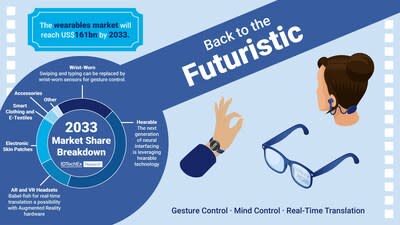Back to the Futuristic: 3 Game-Changing Wearable Technologies Coming Soon, Explored by IDTechEx
BOSTON, May 4, 2023 /PRNewswire/ -- Consumer technology available today is impressive but still not as cool as promised by many classic sci-fi movies. Dreams of hoverboards and holograms have been replaced by stagnating smartphone designs and doom-scrolling. Yet things look set to change. This article picks out three of the most exciting sci-fi-inspired technologies to feature in IDTechEx's "Wearable Technology Forecasts 2023-2033" report – many of which could be coming to a store sooner than one can think.
Gesture Control
It is hard to discuss gesture control technology without referencing its iconic role in Minority Report. Instead of using a keyboard and mouse to control a computer, the protagonist points, clicks and swipes with his hands. But now, twenty years on, gesture control could finally be about to make its way into homes and workplaces.
So why now? The main driver is the increasing adoption of augmented and virtual reality (AR & VR), with Apple rumored to be releasing an AR headset soon. More private than voice commands and less inconvenient than a hand-held controller, gesture control is ideally suited to AR and VR.
Most gesture control systems being developed are based on weak electrical signals produced by the body during movements (e.g. electromyography or EMG). Software is trained to recognize these signals as a pinch, swipe, or finger movement – and subsequently into an instruction to click, scroll, or type. However, obtaining high-enough quality signals to achieve this is a significant challenge – particularly within convenient form factors. As a result, multiple players are now competing to offer an optimal combination of wrist-worn wearable sensors and data processing algorithms. For example, Wearable Devices Ltd 'Mudra' band utilizes proprietary material engineering to enhance electrode conductance. In discussions with IDTechEx, companies have outlined that the most advanced gesture control will require multiple sensors distributed along the length of a watch wristband – arguably a great opportunity for printed and flexible electronics.
Overall, as market demand and technological possibilities converge, an era of gesture-controlled human-computer interfaces is coming. Early adoption into the industry for worker safety has already begun, paving the way for Spielsburg's vision of gesture control to come to life in the near future.
Mind Control
Mind-control powers stemming from technology have regularly been depicted in cinema: think Dr Octopus in Spiderman or Neo in the Matrix). In the real world, genuine neural interfacing technology, including wearable brain-computer interfaces (BCI), is advancing fast. Moreover, the transition of this technology from scientists to consumers is now on the horizon. As with gesture control, part of the demand for BCI stems from the need for alternative device control systems.
Neural interfacing already has a long history of development for the healthcare market. Diagnosing epilepsy and sleep disorders depends on the measurement of electrical signals generated by the brain (EEG). To improve the user experience of patients, there has been significant investment in dry electrode technology to omit the need for messy gels – and miniaturization of the systems to fit them within headsets, electronic skin patches, and even earbuds. In these form factors, the technology is more suited to the consumer market than it has been in the past. As a result, it's found applications beyond diagnostics and has been sold to advertisers looking to assess emotional responses to marketing campaigns. Admittedly, the advancements necessary to progress from emotional state monitoring to 'mind-controlled' devices are still significant. Yet Boston Scientific has already shown implantables capable of controlling exoskeletons and Elon Musk's Neuralink is scaling up production of devices specifically targeting consumer device control.
The next few years are set to be particularly exciting when it comes to wearable neural interfacing for the consumer market. If non-invasive hardware and software solutions continue to improve at the current rate, consumer 'mind control' technology could even surpass that seen in the movies, perhaps requiring only earphones.
Real-Time Translation
Demonstrated as a Babel fish in A Hitchhikers Guide to the Galaxy, real-time translation could disrupt swathes of the tourism, business, and healthcare industry. Miniaturized display technology for augmented reality is progressing rapidly – combined with sophisticated computer processing within the device, real-time translation on sunglasses could soon be a part of people's holidays.
Ray Neo has already developed a prototype device for Chinese-English (which IDTechEx was lucky enough to try out at CES 2023). Challenges certainly remain, for example optimizing the system to only translate the audio of interest, and not everything in the range, but the performance of the AR optics technology was certainly sufficient.
Despite much effort and investment, AR/VR technology hasn't demonstrated the growth some expected, arguably due to the lack of a 'killer app' – real-time translation could arguably be the use case that drives demand. This capability would also benefit those in need of assistive technology, converting audio to text and vice versa for the hearing and visually impaired. This reality would combine cinemas' promise of smart glasses and real-time translation while delivering tangible benefits.
Outlook
Further discussion of all of these themes and many more are covered in IDTechEx's latest report, "Wearable Technology Forecasts 2023-2033". This report contains granular 10-year market forecasts of the wearables industry, consisting of 45 forecast lines across five key wearable technology sectors: wrist-worn wearables (smartwatches), hearables, AR and VR headsets, electronic skin patches, and smart clothing, and e-textiles.
To find out more about the IDTechEx wearable tehcnology portfolio, including downloadable sample pages, please visit www.IDTechEx.com/research/WT.
Author: Dr Tess Skyrme, Technology Analyst at IDTechEx
About IDTechEx
IDTechEx guides your strategic business decisions through its Research, Subscription and Consultancy products, helping you profit from emerging technologies. For more information, contact research@IDTechEx.com or visit www.IDTechEx.com.
Images Download:
https://www.dropbox.com/scl/fo/2p3pveqtmrffyk7hvgcr9/h?dl=0&rlkey=nia1g3mmvyiawv6lcx547u909
Media Contact:
Lucy Rogers
Sales and Marketing Administrator
press@IDTechEx.com
+44(0)1223 812300
Social Media Links:
Twitter: www.twitter.com/IDTechEx
LinkedIn: www.linkedin.com/company/IDTechEx
Facebook: www.facebook.com/IDTechExResearch
Photo: https://mma.prnewswire.com/media/2065302/Back_to_the_Futuristic.jpg
Logo: https://mma.prnewswire.com/media/478371/IDTechEx_Logo.jpg


View original content to download multimedia:https://www.prnewswire.com/news-releases/back-to-the-futuristic-3-game-changing-wearable-technologies-coming-soon-explored-by-idtechex-301810977.html
SOURCE IDTechEX


